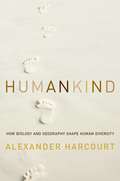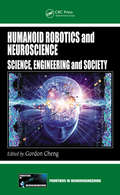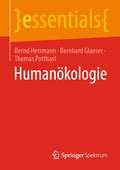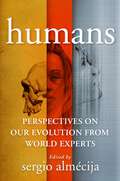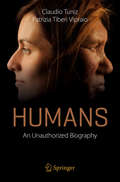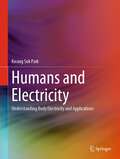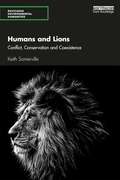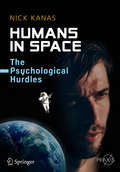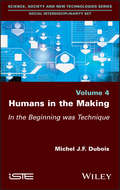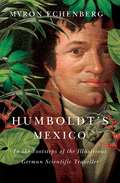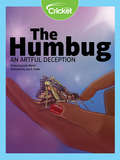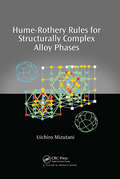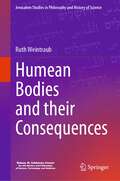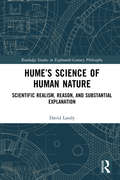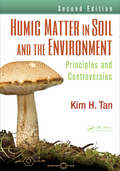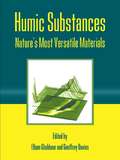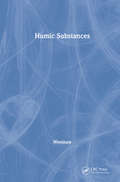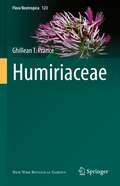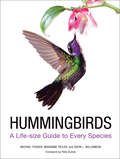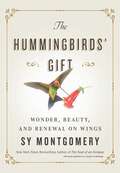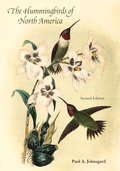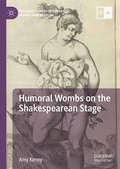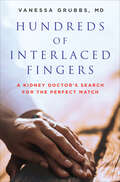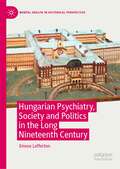- Table View
- List View
Humankind: How Biology and Geography Shape Human Diversity
by Alexander H. HarcourtAn innovative and illuminating look at how the evolution of the human species has been shaped by the world around us, from anatomy and physiology, to cultural diversity and population density. Where did the human species originate? Why are tropical peoples much more diverse than those at polar latitudes? Why can only Japanese peoples digest seaweed? How are darker skin, sunlight, and fertility related? Did Neanderthals and Homo Sapiens ever interbreed? In Humankind, U. C. Davis professor Alexander Harcourt answers these questions and more, as he explains how the expansion of the human species around the globe and our interaction with our environment explains much about why humans differ from one region of the world to another, not only biologically, but culturally. What effects have other species had on the distribution of humans around the world, and we, in turn, on their distribution? And how have human populations affected each other's geography, even existence? For the first time in a single book, Alexander Harcourt brings these topics together to help us understand why we are, what we are, where we are. It turns out that when one looks at humanity's expansion around the world, and in the biological explanations for our geographic diversity, we humans are often just another primate. Humanity's distribution around the world and the type of organism we are today has been shaped by the same biogeographical forces that shape other species.
Humanoid Robotics and Neuroscience: Science, Engineering and Society
by Gordon ChengHumanoid robots are highly sophisticated machines equipped with human-like sensory and motor capabilities. Today we are on the verge of a new era of rapid transformations in both science and engineering-one that brings together technological advancements in a way that will accelerate both neuroscience and robotics. Humanoid Robotics and Neuroscienc
Humanökologie (essentials)
by Bernd Herrmann Bernhard Glaeser Thomas Potthastessentials liefern aktuelles Wissen in konzentrierter Form. Die Essenz dessen, worauf es als „State-of-the-Art“ in der gegenwärtigen Fachdiskussion oder in der Praxis ankommt. essentials informieren schnell, unkompliziert und verständlichals Einführung in ein aktuelles Thema aus Ihrem Fachgebietals Einstieg in ein für Sie noch unbekanntes Themenfeldals Einblick, um zum Thema mitreden zu könnenDie Bücher in elektronischer und gedruckter Form bringen das Expertenwissen von Springer-Fachautoren kompakt zur Darstellung. Sie sind besonders für die Nutzung als eBook auf Tablet-PCs, eBook-Readern und Smartphones geeignet. essentials: Wissensbausteine aus den Wirtschafts-, Sozial- und Geisteswissenschaften, aus Technik und Naturwissenschaften sowie aus Medizin, Psychologie und Gesundheitsberufen. Von renommierten Autoren aller Springer-Verlagsmarken.
Humans: Perspectives on Our Evolution from World Experts
by Sergio AlmécijaHow did humanity evolve? And what does our evolutionary history tell us about what it means to be human? These questions are fundamental to our identity as individuals and as a species and to our relationship with the world. But there are almost as many answers to them as there are scientists who study these topics.This book brings together more than one hundred top experts, who share their insights on the study of human evolution and what it means for understanding our past, present, and future. Sergio Almécija asks leading figures across paleontology, primatology, archaeology, genetics, and many other disciplines about their lives, their work, and the philosophical significance of human evolution. They reflect on questions that are both fun and profound: What set you down your career path? Are humans special? Where and when would you travel in a time machine? Does human evolution offer lessons for society? Is evolution compatible with spirituality and religion?Humans features a remarkably accomplished cast of contributors, including Kay Behrensmeyer, Frans de Waal, Nina Jablonski, Richard Leakey, Robert Sapolsky, and Richard Wrangham. Together, they provide a refreshing, personable, engaging, cross-disciplinary, and thought-provoking exploration of different—even diametrically opposed—ideas about our nature and evolution, what makes humans unique, and what our future might hold. This book also offers practical suggestions for readers seeking to embark on a scientific career.
Humans
by Claudio Tuniz Patrizia Tiberi VipraioBased on the latest scientific discoveries, this "unauthorized biography" of the Humans recounts the story of our distant ancestors during the past 6 million years, since the line of our extended family separated from that leading to modern chimpanzees. The book explains how different species evolved, both anatomically and cognitively, and describes the impacts of climatic and environmental change on this process. It also explores the nature of relationships within and between species, describes their everyday lives, and discusses how isolated individuals became members of larger social groups. The concluding chapters highlight the paramount importance of the emergence of symbolic thought and discuss its contribution to the formation of institutions, societies, and economies. The multifaceted picture that emerges will help the reader to make sense not only of "what we were", but also of "what we are", here and now. The book is both entertaining and rigorous in integrating results from a wide selection of disciplines. It will be particularly suitable for people with a curious and open mind, keen to overcome long-standing prejudices on man's place in nature.
Humans and Electricity: Understanding Body Electricity and Applications
by Kwang Suk ParkHumans are electric beings. We are managed, monitored, and stimulated electrically. This textbook provides students and practitioners with a solid foundation and understanding of human electricity and the work currently being done to further develop electrical signals for medical purposes and related goals. The book introduces the fundamentals of how biological systems generate electrical signals, covering a wide range of biomedical engineering topics including bioelectricity, biomedical signals, neural engineering, and brain-computer interface. The book is presented in three sections: Part I explains how electrical signals and impulses manage the human body; Part II examines the kinds of electrical signals from the human body and how they are monitored, controlled, and used; Part III looks at clinical use of electrical stimulation toward the human body and how they are being developed for interventions in medicine. The book is also a valuable professional reference for practicing engineers and scientists. Explains humans as electric beings who are managed, monitored, and stimulated electrically;Deals with the electricity of major human organs;Covers a wide range of biomedical engineering topics
Humans and Lions: Conflict, Conservation and Coexistence (Routledge Environmental Humanities)
by Keith SomervilleThis book places lion conservation and the relationship between people and lions both in historical context and in the context of the contemporary politics of conservation in Africa. The killing of Cecil the Lion in July 2015 brought such issues to the public’s attention. Were lions threatened in the wild and what was the best form of conservation? How best can lions be saved from extinction in the wild in Africa amid rural poverty, precarious livelihoods for local communities and an expanding human population? This book traces man’s relationship with lions through history, from hominids, to the Romans, through colonial occupation and independence, to the present day. It concludes with an examination of the current crisis of conservation and the conflict between Western animal welfare concepts and sustainable development, thrown into sharp focus by the killing of Cecil the lion. Through this historical account, Keith Somerville provides a coherent, evidence-based assessment of current human-lion relations, providing context to the present situation. This book will be of interest to students and scholars of environmental and African history, wildlife conservation, environmental management and political ecology, as well as the general reader.
Humans and Their Place in the Universe (Inspire Science, Grade 8 Integrated #Unit 4)
by Alton L. Biggs Ralph M. Feather Douglas FisherNIMAC-sourced textbook
Humans in Space
by Nick KanasUsing anecdotal reports from astronauts and cosmonauts, and the results from studies conducted in space analog environments on Earth and in the actual space environment, this book broadly reviews the various psychosocial issues that affect space travelers. Unlike other books that are more technical in format, this text is targeted for the general public. With the advent of space tourism and the increasing involvement of private enterprise in space, there is now a need to explore the impact of space missions on the human psyche and on the interpersonal relationships of the crewmembers. Separate chapters of the book deal with psychosocial stressors in space and in space analog environments; psychological, psychiatric, interpersonal, and cultural issues pertaining to space missions; positive growth-enhancing aspects of space travel; the crew-ground interaction; space tourism; countermeasures for dealing with space; and unique aspects of a trip to Mars, the outer solar system, and interstellar travel.
Humans in the Making: In the Beginning was Technique
by Michel J. DuboisThe human specificity can be described by verticality/bipedalism, technique use, articulated language, high cognitive capacities, complex society at three levels: body, mind, social. In this book, is proposed an evolutionary process that make better understand how such humanity could have emerged in the long time (more than 6 million years). The process is based on a very early necessity to use technic for surviving correlated with neoteny which impulsed a darwinian evolutionary process, with four distinguished punctuation described as neotenizations.
Humboldt's Mexico: In the Footsteps of the Illustrious German Scientific Traveller
by Myron EchenbergThe incalculable influence of Alexander von Humboldt (1769–1859) on biology, botany, geology, and meteorology deservedly earned him the reputation as the world’s most illustrious scientist before Charles Darwin. Humboldt’s breath-taking explorations of Mexico and South America from 1799 to 1804 are akin to Europe’s second “discovery” of the New World – this time, a scientific one. His Political Essay on the Kingdom of New Spain is a foundational document about Mexico and its cultures and is still widely consulted by anthropologists, geographers, and historians. In Humboldt’s Mexico, Myron Echenberg presents a straightforward guide with historical and cultural context to Humboldt’s travels in Mexico. Humboldt packed a lifetime of scientific studies into one daunting year, and soon after published a four-volume account of his findings. His adventures range widely from inspections of colonial silver mines and hikes to the summits of volcanoes to meticulous examination of secret Spanish colonial archives in Mexico City and scientific discussions of archaeological sites of pre-Hispanic Indigenous cultures. Echenberg traces Humboldt’s journey, as described in his publications, his diary, and other writings, across the heartland of Mexico, while also pursuing Humboldt’s life, his science, his experiences, his influence on scholars of his time and after, and the various efforts by others to honour and at times to denigrate his legacy. Part history, part travelogue, and always highly readable and informative, Humboldt’s Mexico is an engaging account of a gifted scientist and visionary that ranges across topics as diverse and broad as natural history was in his era.
The Humbug: An Artful Deception
by Justin WerfelAfter Dr. Harriet Weisz receives a message about a newly discovered species of insect, further research into insect DNA and genetics reveals an unexpected twist. Her work leads her into a world of hoaxes and frauds, all perpetuated in the name of combining science and art, as well as scientific accountability.
Hume-Rothery Rules for Structurally Complex Alloy Phases
by Uichiro MizutaniWith a history that reaches back some 90 years, the Hume-Rothery rules were developed to provide guiding principles in the search for new alloys. Ultimately, the rules bridged metallurgy, crystallography, and physics in a way that led to the emergence of a physics of the solid state in 1930s, although the physical implications of the rules were nev
Humean Bodies and their Consequences (Jerusalem Studies in Philosophy and History of Science)
by Ruth WeintraubThis book defends the very contentious Idealist interpretation of Hume on external objects, and draws from it far-reaching metaphysical and epistemological consequences for Hume’s philosophy. Its interest is both interpretive and analytic. The content Hume ascribes to the belief in “bodies” is susceptible to more than one reading, and has not been systematically considered. Upholding the Idealistic interpretation is interesting in its own right, but also yields several important conclusions about the spatiality of objects, causation, Hume’s “science of man” and his epistemology. For instance, it argues that the Idealist reading means that there are no cross-temporal spatial relationships, and that the (more prevalent) Materialist reading takes Hume further away from methodological empiricism than does the Idealist counterpart, and may render his practice less in conformity with his official methodology. The monograph is therefore of great interest to not only academics but also scholars, graduate students and researchers.
Hume’s Science of Human Nature: Scientific Realism, Reason, and Substantial Explanation (Routledge Studies in Eighteenth-Century Philosophy)
by David LandyHume’s Science of Human Nature is an investigation of the philosophical commitments underlying Hume's methodology in pursuing what he calls ‘the science of human nature’. It argues that Hume understands scientific explanation as aiming at explaining the inductively-established universal regularities discovered in experience via an appeal to the nature of the substance underlying manifest phenomena. For years, scholars have taken Hume to employ a deliberately shallow and demonstrably untenable notion of scientific explanation. By contrast, Hume’s Science of Human Nature sets out to update our understanding of Hume’s methodology by using a more sophisticated picture of science as a model.
Humic Matter in Soil and the Environment: Principles and Controversies, Second Edition (Books in Soils, Plants, and the Environment)
by Kim H. TanThe field of humic matter research has undergone drastic changes in concepts and principles since the first edition of Humic Matter in Soil and the Environment: Principles and Controversies was published more than a decade ago. Still the only book of its kind specifically addressing humic acid principles and controversies, the Second Edition presen
Humic Substances: Nature's Most Versatile Materials
by E. Ghabbour G. DaviesHumic substances are ubiquitous in the environment. These remarkable brown biomaterials are found in animals, plants, coals, sediments, soils and water. They are crucial components of the carbon cycle and other life processes. Humic Substances: Nature's Most Versatile Materials contains a compilation of papers presented at the 2002 Humic Substances Seminar and will keep humic substances scientists up to date with the latest research.
Humic Substances
by Robert L. Wershaw Michael A. MikitaThis book is an introduction and guide to the use of nuclear magnetic resonance (NMR) spectroscopy for the study of humic materials and coals. It provides a general discussion of the application of liquid-state and solid-state NMR techniques.
Humiriaceae (Flora Neotropica #123)
by Ghillean T. PranceThis book provides a comprehensive monograph of the family Humiraceae. It includes information on economic botany, conservation, phylogenetic relationships, taxonomic history, ecology, cytology, anatomy, and phytochemistry, among other topics. This volume is illustrated with line drawings, black and white photographs, and distribution maps. It was written by the world-leading authority on this plant group and contains a total of eight genera, 65 species, and 15 infraspecific taxa, with two new species described. This work is volume 123 in the Flora Neotropica book series (Lawrence M. Kelly, Editor-in-Chief). Flora Neotropica volumes provide taxonomic treatments of plant groups or families growing in the Americas between the Tropic of Cancer and the Tropic of Capricorn.
Hummingbirds: A Life-size Guide to Every Species
by Michael Fogden Marianne Taylor Sheri L. Williamson“Packed with information . . . this book showcases species such as the Green-crowned Brilliant, the Fiery Topaz and . . . Cuban Bee Hummingbird.” —Daily MailHummingbirds have always held popular appeal, with their visual brilliance, extraordinary flight dexterity, jewel-like color, and remarkably small size.This is the first book to profile all 338 known species, from the Saw-billed Hermit to the Scintillant Hummingbird.Every bird is shown life-size in glorious full-color photographs.Every species profile includes a flight map and key statistics, as well as information about behavior, plumage, and habitat.This authoritative guide has been annotated by the world’s leading experts on hummingbirds and features a foreword by renowned birding author Pete Dunne.
The Hummingbirds' Gift: Wonder, Beauty, and Renewal on Wings
by Sy MontgomeryFrom the beloved New York Times bestselling author of the &“fascinating…entertaining&” (The Daily Beast) National Book Award finalist The Soul of an Octopus, a charmingly perfect gem of a book about the most exquisite and extraordinary of winged creatures—hummingbirds.As one of the most beautiful and intriguing birds found in nature, hummingbirds fascinate people around the world. The lightest birds in the sky, hummingbirds are capable of incredible feats, such as flying backwards, diving at speeds of sixty-one MPH, and beating their wings more than sixty times a second. Miraculous creatures, they are also incredibly vulnerable when they first emerge from their eggs. That&’s where Brenda Sherburn comes in. With tenderness and patience, she rescues abandoned hummingbirds and nurses them back to health until they can fly away and live in the wild. In The Hummingbird&’s Gift, the extraordinary care that Brenda provides her peanut-sized patients is revealed and, in the process, shows us just how truly amazing hummingbirds are. With Sy Montgomery&’s signature &“joyful passion&” (Library Journal), and including sixteen pages of gorgeous color photos, this beautifully written and inspiring little book celebrates the profound gift that hummingbirds are to our planet and is the ultimate gift for nature lovers and bird watchers everywhere.
The Hummingbirds of North America, Second Edition
by Paul A. JohnsgardSwift and iridescent, hummingbirds are found only in the New World, and encompass an amazing variety of specializations. No other family of birds can lay claim to so many superlatives, including smallest size, most rapid wingbeat, and most specialized plumages. While many species can be attracted to feeding stations and backyard flower gardens, others can be found only in the wild.Paul A. Johnsgard's Hummingbirds of North America is the only book devoted to the identification, distribution, and biology -- both individual and comparative -- of all hummingbirds that breed in North America. First published in 1983, this acclaimed volume now has been revised and expanded to include twenty-five Mexican species, such as the long-billed starthroat and the fork-tailed emeralds, thereby more than doubling the species coverage of the original edition. Full species-by-species accounts survey the evolutionary history, anatomical and physiological specializations, and comparative ecology, behavior, and reproductive biology of this largest family of nonpasserine birds. Individual accounts are complemented by 24 full-color paintings.Including updated range maps, identification keys, and a bibliography that has been broadened to include literature on the little-known Mexican species, the book is both accessible to amateur birders and an authoritative volume for ornithologists.
Humoral Wombs on the Shakespearean Stage (Palgrave Studies in Literature, Science and Medicine)
by Amy KennyThis book explores how the humoral womb was evoked, enacted, and embodied on the Shakespearean stage by considering the intersection of performance studies and humoral theory. Galenic naturalism applied the four humors—yellow bile, black bile, phlegm, and blood—to delineate women as porous, polluting, and susceptible to their environment. This book draws on early modern medical texts to provocatively demonstrate how Shakespeare’s canon offers a unique agency to female characters via humoral discourse of the womb. Chapters discuss early modern medicine’s attempt to theorize and interpret the womb, specifically its role in disease, excretion, and conception, alongside passages of Shakespeare’s plays to offer a fresh reading of (geo)humoral subjectivity. The book shows how Shakespeare subversively challenges contemporary notions of female fluidity by accentuating the significance of the womb as a source of self-defiance and autonomy for female characters across his canon.
Hundreds of Interlaced Fingers: A Kidney Doctor's Search for the Perfect Match
by Vanessa GrubbsA doctor shares her unforgettable love story & informative journey into the world of medicine in this “thoughtful and endearing” memoir (Washington Post).When Vanessa met Robert, she had no idea that their relationship would thoroughly transform her life. Robert was suffering from end-stage kidney disease, which required him to endure years of debilitating dialysis in order to stay alive, at least until his failed organ could be replaced by a kidney transplant. Although Vanessa was a primary care doctor, she developed a deeper understanding of the difficulties Robert faced, including dialysis and finding a donor. So, even though they were still in the early stages of their relationship, she volunteered one of her own kidneys for testing and discovered that she was a match. This life-affirming donation forged a bond that would become a pillar of Vanessa and Robert’s marriage—and the beginning of a new career.Motivated by Robert’s experience and her newfound knowledge, Vanessa became a nephrologist—a kidney doctor—and discovered far more about the realities of the specialty. Shaped by Vanessa’s remarkable expertise as a doctor, a woman of color, a mother, and a kidney donor, Hundreds of Interlaced Fingers is a love story as well as an informative guide to kidney disease.Praise for Hundreds of Interlaced Fingers“A story told beautifully, courageously, and honestly. You’ll never forget Vanessa and Robert, and you’ll never view medicine quite the same way again.” —Robert Winchester, MD, author of the New York Times–bestseller The Digital Doctor“Intense, ambitious, and fascinating.” —Victoria Sweet, MD, award–winning author of God’s Hotel
Hungarian Psychiatry, Society and Politics in the Long Nineteenth Century (Mental Health in Historical Perspective)
by Emese LaffertonThis book provides the first comprehensive study of the history of Hungarian psychiatry between 1850 and 1920, placed in both an Austro-Hungarian and wider European comparative framework. Taking an interdisciplinary approach, the book captures the institutional worlds of the different types of psychiatric institutions intertwined with the intellectual history of mental illness and the micro-historical study of everyday institutional practice. It uncovers the ways in which psychiatrists gradually organised themselves and their profession, defined their field and role, claimed expertise within the medical sciences, lobbied for legal reform and the establishment of psychiatric institutions, fought for university positions, the establishment of departments and specialised psychiatric teaching. Beyond this story of increasing professionalization, this study also explores how psychiatry became invested in social critique. It shows how psychiatry gradually moved beyond its closely defined disciplinary borders and became a public arena, with psychiatrists broadening their focus from individual patients to society at large, whether through mass publications or participation in popular social movements. Finally, the book examines how psychiatry began to influence the concept of mental health during the first decades of the twentieth century, against the rich social and cultural context of fin-de-siècle Budapest and the Austro-Hungarian Dual Monarchy.
